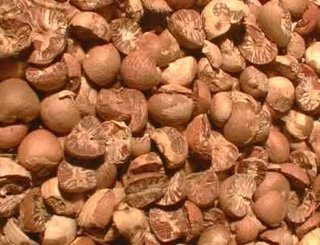 Bangladeshis have always been a colony of betelnut addicts. ‘My’ extensive and ‘paranormal’ research studies show that betelnut sessions help the secretion of our brains opiates, drugging us often to the point of excitement or euphoria.Our obsession with individuality and individual freedom, accompanied by loneliness, is nothing but a major source of stress – related brain opiates.
Bangladeshis have always been a colony of betelnut addicts. ‘My’ extensive and ‘paranormal’ research studies show that betelnut sessions help the secretion of our brains opiates, drugging us often to the point of excitement or euphoria.Our obsession with individuality and individual freedom, accompanied by loneliness, is nothing but a major source of stress – related brain opiates.The Good Samaritan…
Those of you old and wise enough as yours truly will love this one. When I was at school I was a big fan of Aminur Rahman and his “Dunia Ulti Gese”. One of my favourite scenes is when a kind hearted Samaritan unexpectedly decides to play the reluctant hero. He assumes that a deshi auntie is ‘bleeding/ seeping or spitting blood from the mouth. Full of empathy for a fellow human he hails an ambulance in desperation.
 The dear in question, who speaks little English is frogmarched to the A&E, where with the aid of an interpreter the furious chachi spits blood (get it), brimstones and venom all at once. She then quietly explains that she was in fact chewing betelnut supari and not suffering bleeding gums. I could almost hear the laughter from Sylhet. A classic but absolutely hilarious moment from Bangladeshi melodrama. Betelnuts from the Areca tree are also known as ‘palm nuts’. The scientific name for the tree is ‘Areca Catechu’ and resembles a thin coconut palm tree. These hard nuts are chewed causally like chewing gum by Deshis and are a permanent feature of culture. Those foreign to Deshi culture do not always comprehend why the people chew it, let alone in combination with other additives. Chewing betelnut is an inherent feature of Deshi social gatherings or fellowship, which imbues the spirit of family goodwill to strangers. When I visited Bangladesh I noticed that the girls dressed in beautiful coloured tunics and the older women of the village kept smiling at me, their teeth blackened with betelnut juice. I noticed that for the seasoned chewer, the chewing tobacco brand ‘Baba Zarda’ is mixed with the nut and leaf. For the brave at heart, Chuna or lime powder is also incorporated into the chewing experience. Lime is an Alkaline white powder residue, which results from cooking coral overran intense bonfire for several days.
The dear in question, who speaks little English is frogmarched to the A&E, where with the aid of an interpreter the furious chachi spits blood (get it), brimstones and venom all at once. She then quietly explains that she was in fact chewing betelnut supari and not suffering bleeding gums. I could almost hear the laughter from Sylhet. A classic but absolutely hilarious moment from Bangladeshi melodrama. Betelnuts from the Areca tree are also known as ‘palm nuts’. The scientific name for the tree is ‘Areca Catechu’ and resembles a thin coconut palm tree. These hard nuts are chewed causally like chewing gum by Deshis and are a permanent feature of culture. Those foreign to Deshi culture do not always comprehend why the people chew it, let alone in combination with other additives. Chewing betelnut is an inherent feature of Deshi social gatherings or fellowship, which imbues the spirit of family goodwill to strangers. When I visited Bangladesh I noticed that the girls dressed in beautiful coloured tunics and the older women of the village kept smiling at me, their teeth blackened with betelnut juice. I noticed that for the seasoned chewer, the chewing tobacco brand ‘Baba Zarda’ is mixed with the nut and leaf. For the brave at heart, Chuna or lime powder is also incorporated into the chewing experience. Lime is an Alkaline white powder residue, which results from cooking coral overran intense bonfire for several days. During my brief sojourn my requests for the old dears of the village to mix West Indian Tabasco sauce as a condiment for their betelnut savouries, surprisingly always fell on deaf ears. Betelnut is frequently chewed with the betel leaf, a fresh green peppery tasting condiment. The leaf is known as ‘Pan’. Betelnut is chewed and harvested by millions of people from Bangladesh, India, Vietnam, Sri Lanka, Indonesia, Philippines and American Samoa. The trees are found growing in moist ground and produce prodigious clusters of green fleshy nuts, which then mature into yellow then brown hard nuts.
During my brief sojourn my requests for the old dears of the village to mix West Indian Tabasco sauce as a condiment for their betelnut savouries, surprisingly always fell on deaf ears. Betelnut is frequently chewed with the betel leaf, a fresh green peppery tasting condiment. The leaf is known as ‘Pan’. Betelnut is chewed and harvested by millions of people from Bangladesh, India, Vietnam, Sri Lanka, Indonesia, Philippines and American Samoa. The trees are found growing in moist ground and produce prodigious clusters of green fleshy nuts, which then mature into yellow then brown hard nuts.Betelnut wisdom. Bizarre but true…
My sources in shady places inform me of an American who was having breakfast one morning in a Dhaka hotel. (Coffee, rusks, bread, butter and jam) When a Deshi Babu, chewing betelnut supari, sat down next to him. The American casually ignored the Babu who, nevertheless, embarked on a conversation.
Babu: ‘Americans eat the whole rusk, crusts and all??’
American (in a bad mood): ‘Of course’
Babu: (after gobbing a huge red patch next to the yankies feet) ‘we don’t. We only eat the insides. Crusts we collect in a container, recycle them, transform them into rusks and sell them to the states as delicacies.’ The Babu has a smirk on his face. The American listens in silence.
Babu persists: ‘Do you eat jelly (jam) with the bread and rusks??’
American: ‘Of course’
Babu: (cracking his betelnut between his teeth and chuckling,)’! We don’t. Here we eat fresh fruit for breakfast, then we put all the peels, seeds, and leftovers in containers, recycle them, transform them into jam and sell the jam to the states. Tee Hee Hee! Just then the American stood up in a rage: I’ve had enou…’
Before he could finish, his face turned beetroot red and abruptly clutching his chest (and nether regions) he hit the deck. The shocked Babu immediately came to his aid as a small crowd gathered, whilst the American continued to turn darker shades of red. Somebody suggested mouth – to – mouth resuscitation. Babu, blaming himself for the collapse, and desperate to make amends dived in.
After several attempts the American seemed to thankfully return to normal. He sat up groggily: ‘Babu, thanks for that, especially since you widely contributed to that scene. I’ve know got chunks of slimy betelnut remnants in my mouth, but hell who gives a Dunkin Doughnut, I’m living and I’ll be damned if I complain’ he sneered. ‘It’s not betelnut’, replied Babu, ‘I forgot to tell you I’m suffering from bronchitis’.
Basic Facts from the Boffins…

Quint: The ultimate betelnutter
D. Stern and Douglas B. Hanson, Forsyth institution for advance Research, Boston, analysed the microscopic and chemical nature of prehistoric betel – stained teeth. While betel – chewing nuts, sprinkled with slaked lime and wrapped in a betel leaf produces a very bitter and sharp tasting chewable poultice it also results in heavily stained/worn teeth and also forms cavities.
Their investigation revealed that structural and elemental changes occurred in the enamel of betel – stained teeth of Chamorus thousands of years ago, which now results in anti – cavity properties of betel – chewing. The cultural habit endures to this day.
The ultimate ‘betelnutter’…
One of my bestest ‘betelnutters’ is Quint from Steven Spielberg’s masterpiece, Jaws (I only say betelnut because of his chewing style). Quint, to put it politely
is a grizzly, salty fisherman and WWII veteran (Robert Shaw) obsessed in hunting and killing the great white from a boat named The Orca.
I love the classic scene when Quint, the eccentric, grizzled shark hunter makes a dramatic entrance by silencing the commotion of the meeting. The colourful old sea- salt with a brogue - accent scrapes his fingernails irritatingly across the blackboard (With a drawn/doodled outline of The Great White Shark with a human being in its tooth- rimmed mouth) at the back of the audience to get everybody’s attention.
As the camera slowly pans towards him, while he munches on a salty cracker, the foul – mouthed (supposed) betelnutter proposes to rid the town of the menacing, deadly shark for $10,000: ‘$10,000 dollars for me by myself. For that you get the head, the tail, and the whole damn thing’
Before anybody wonders where I’m leading, readers I’ll get down to the grind and ask you the million dollar question, which is: when Carcharodon Carcharias eventually snares the master shark killer by the hips. Does he spit out blood or betelnut juice? I’m not sick, neither am I depraved!
Did you know that betelnut is used medicinally in the treatment for intestinal worms. But by far the most common use is in the ritual chewing of the betel – killi. This habit is widespread throughout Asia, India and the Pacific, making it one of the most popular stimulants (I bet) in the world. Generally the betel – killi is a small morsel consisting of a quarter betel seed (crushed), a pinch of lime, spices like cardamom or nutmeg for flavour all wrapped in a pan leaf. It is traditional for the men also to add Tobacco to the package.
This killi is chewed slowly over several hours, causing mild stimulation and a feeling of wellbeing. The question remains unanswered. Is it good for you or bad? Does betelnut and pan with all the added spices give you oral cancer or is it a ‘stimulant’ that promotes a feeling of wellbeing? All answers c/o the Editor.
No comments:
Post a Comment